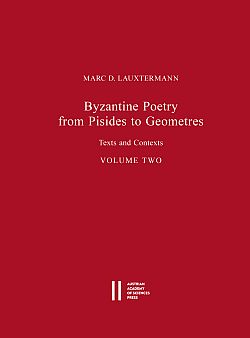
This second and last volume of Byzantine Poetry from Pisides to Geometres offers a comprehensive overview of the main poetic genres between c. 600 and 1000, combining textual analysis and contextual interpretation. The first three chapters discuss encomium, ekphrasis and ethopoiia – the three archigenres or discursive modes that, together with narration, inform the whole of Byzantine literature. The next two deal with specific rhetorical genres: monody and epithalamium. This then is followed by an account of satire, diatribe and religious poetry, all three of which tend to be rather personal: they are all forms of self-representation. The next two chapters take us to school: the first deals with didactic poetry; the second with metaphrasis, a school exercise. The last chapter treats oracles, riddles and dream keys. The book is concluded with an ‘appendix metrica’, which offers a detailed and thorough account of Byzantine metrics. Given that the first volume, which appeared in 2003, has become essential reading for all those interested in Byzantine literature, the second volume is likely to set the agenda for further research.
…
Dieser zweite und letzte Band der „Byzantine Poetry from Pisides to Geometres“ bietet einen umfassenden Überblick über die wichtigsten poetischen Genres zwischen ca. 600 und 1000 und kombiniert Textanalyse mit kontextueller Interpretation. Die ersten drei Kapitel beschäftigen sich mit Enkomium, Ekphrasis und Ethopoiia — den drei Archigenres oder Diskursformen, die zusammen mit der Erzählung die gesamte byzantinische Literatur gestalten. Die nächsten zwei Kapitel befassen sich mit bestimmten rhetorischen Genres: Monodie und Epithalamium. Dem folgt eine Gesamtübersicht über Satire, Diatribe und religiöse Poesie, die alle eher persönlich sind: Sie sind Formen der Selbstrepräsentation. Die nächsten zwei Kapitel führen uns in die Schule: Das erste befasst sich mit didaktischer Poesie; das zweite mit Metaphrasis, einer Schulübung. Das letzte Kapitel behandelt Orakel, Rätsel und Traumschlüssel. Das Buch wird mit einem „Appendix metrica“ abgeschlossen, der eine detaillierte und gründliche Darstellung der byzantinischen Verslehre bietet. Da der erste Band (erschienen 2003) für alle, die sich für die byzantinische Literatur interessieren, zu einer wesentlichen Lektüre geworden ist, liegt es auf der Hand, dass der zweite Band die Agenda für weitere Forschungen bestimmen wird.
2019,
978-3-7001-8126-2
978-3-7001-8458-4
431 Seiten,
24x17cm, broschiert